[ "Back to Berlin" is the title of the 11th edition of Raudio's mainstream. It contains extracts of the tapes found in Berlin, some isolated oddities and parts of the synth recording I made when visiting Berlin way back in 1984. All is centered around "Kentucky Freedom Chicken - The Master of Germany", a selection of several hundreds of extracts taken from the about 18 hours of field recordings that I made during and around das kleine field recordings festival in Berlin (monophonic using my dictaphone, and stereo on an MD recorder), between february 6th and february 13th of 2007 ... Now listen to this ... ]
Fluxissage
april 25, 2007.
[ acoustic flux ] [ sonanismo ] [ bergsonian flux ] [ fifty2 ] [ magnetic {eye} ]
The very last couple of days of march I again spent in Berlin, to attend the finissage, on saturday 31st, of the Acoustic Flux exhibition in Kunstprojektraum Takt, the opening of which, in february, I had missed. I used this second short stay at Takt's to prepare a next acquisition in the Found Tapes Exhibition, nr. 71, which meanwhile has been put online.
It also gave me a chance to see, and hear, the other works on show, and spend some fun time with one of the other artists having work on show, Neil McIntee, from Dundee, Scotland.
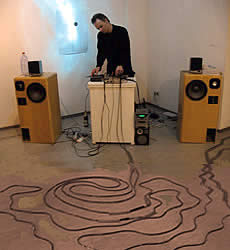 Neil called his work the Electicfluxmachine. With two piezo's he
picked up the continuous electric hum of the large fuses- switch- and meter-box,
in the back of the gallery, amplified the sound, and altered it with a set
of electronic delays and filters. An extremely simple, but effective set-up,
that worked very well within the gallery's space, where the machine's output
due to the reverberation and reflections of the room gave rise to fields
of sound through which one could move almost as if it were through some
thin wavy liquid. On the evening of the finissage he mixed the machine's
output with a shuffle play of the found tapes exhibition's playlist.
Neil called his work the Electicfluxmachine. With two piezo's he
picked up the continuous electric hum of the large fuses- switch- and meter-box,
in the back of the gallery, amplified the sound, and altered it with a set
of electronic delays and filters. An extremely simple, but effective set-up,
that worked very well within the gallery's space, where the machine's output
due to the reverberation and reflections of the room gave rise to fields
of sound through which one could move almost as if it were through some
thin wavy liquid. On the evening of the finissage he mixed the machine's
output with a shuffle play of the found tapes exhibition's playlist.
Along with the found tapes that could be played on a crummy radio cassette/CD player, Neil's work was the only one that actually sounded in the Takt space. The two other pieces were meant to be experienced in private. With headsets.
Alexandre Decoupigny's installation Town Country House (subtitled "a virtually real soundwalk") is a spatial projection of four 'phonographs', four field recordings, through which one can walk - as it were from 'town' into 'country' and on into 'house' - wearing a set of wireless headphones, and going along a straight line in the direction of an ultrasonic sensor detecting the direction, speed and distance of your body moving; and, of course, the sound 'projected' then is adjusted accordingly. An amusing way to experience a 'changing soundscape', which makes one wonder whether it would be possible to extend the principle to other movements, for example in a plane, in two dimensions, enabling one to walk along a vast 'surface of sounds'. That might open up interesting perspectives and potential from a compositional point of view, which in the current version of course remain somewhat limited, permitting none other than transitions between recordings corresponding to adjacent points in a linear order ...
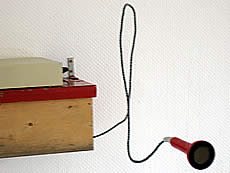 |
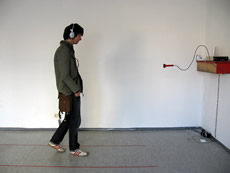 |
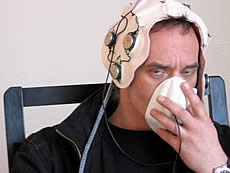 |
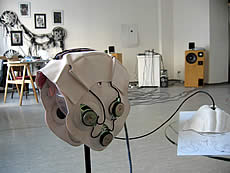 |
[ acoustic flux ] [ sonanismo ] [ bergsonian flux ] [ fifty2 ] [ magnetic {eye} ]
An intriguing looking hatcap with fourteen small loudspeakers and something
like an oxygen mask modeled as a hand containing a contact microphone, are
the hardware elements used to make one undergo Sonanismo
(soundanism), a collaborative project of Miguel Álvarez-Fernández,
Stefan Kersten and Asia Piascik.
Apart from the drawn diagram that also forms the Sonanismo
website frontpage, the installation comes without further explanation
or information. So I put on the hat, had Marcus switch the thing on for
me, and held the mask on my mouth and nose and started breathing (the way
Neil's doing in the picture above). I heard kind of a mash-up of rock tunes
and sounds, louder to the left than to the right. I tried several ways of
breathing - from very calmly to pretty agitated - but none appeared to have
much influence on the sounds, that continued to blurt out (mainly) into
my left ear. I gave up after some ten or fifteen minutes. Maybe there was
something wrong? Some bug? Something not working?
Nobody there to explain. I didn't get to know the artists, though they seem
to have hopped in and out of Takt towards the end of the finissage on saturday
...
There is, however, a twelve page article on the Sonanismo, written by one of the trio, Miguel Álvarez-Fernández. It is in spanish ("Del diálogo a la ilusión de control: Procesos interactivos en la instalación sonora Sonanismo"), but with a little help of automatic translators here and there I did manage to get some understanding of the many-layered ambitions of the Sonanismo. The paper's list of keywords may serve for a first impression: interactivity, sound installation, sound art, masturbation, feedback (retroalimentación), hyperinstrument.
From the paper I learned that ('free translation') "the software underlying
the installation is keeping track of the tempo of the listener's breathing,
by analyzing the information provided by the microphone in the mask, and
then relates in real-time the continuously updated 'breathing regularity
information' to the rhythmical data of a couple of hundreds of sounds, accessible
as a sound archive, all elements of which are in some way or other related
to the phenomenon of masturbation: extracts from porno film soundtracks,
guitar sounds from rock songs (as tokens for onanism in popular culture),
recitation of fragments of Walt Whitman's poem Song of Myself,
repeating sounds of animals and mechanical tools (jackhammers, et cetera)."
The program should pick and play prominently in the 'sound hat' a file with
a tempo corresponding to the tempo of the breathing ... et cetera. I don't
think it ever did for me ... or maybe my breathing's tempo was too ... too
... something ?
Once given the 'masturbation' key, other 'semantic layers' written and/or readable into the Sonanismo installation become more or less obvious. Here is another fragment taken from the paper (in automated Google translation ( * )):
"Between the different interpretativos levels from which this piece can be analyzed, is possible to find in her a reading critical, or at least ironic, with respect to certain typical assumptions of the creative scopes normally denominated like 'digital art', 'electronic art' or 'average art' (scopes within which Sonanismo it can be incardinar easily). Beyond which the own one subject of the masturbation could be understood like one possible appeal to the remarkable endogámico will that it characterizes the diffusion of the practical mentioned ones artistic (since most of the assistants to festivales and samples consecrated to these activities usually are dedicated people more or less directly to those same activities, taking place a peculiar one identification between producers and receivers), the piece also it tries to raise a reflection about concept of interactivity, omnipresent in the mentioned ones aesthetic scopes."
[ acoustic flux ] [ sonanismo ] [ bergsonian flux ] [ fifty2 ] [ magnetic {eye} ]
I have nothing against masturbation ambition.
In order to get somewhere, it may even seem essential to be ambitious. ("Especially as long as you have not done anything yet ...!", a former colleague and renowned logician used to insist.) But for the fact that the piece did not seem to work (for whatever reason, me including), and thus ended up coming across as being pretentious rather than ambitious, and as self-indulgent, as auto-referential, rather than as 'smart' and 'critical / ironic' ...
So, "Слава России !" I'd say ...
That's right.
"Glory to Russia !"
...
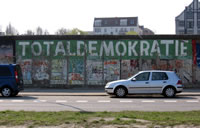 Did
you know that in Germany one actually is allowed to drink alcoholic beverages
from bottles while walking in the streets or riding public transport? Or
maybe one is not. But still, everybody's doing it and nobody seems
to be taking offense. And on fine warm evenings like those of these last
few days of march, you'll come across literally hundreds of bottles of beer
strolling along Berlin pavements, being emptied between one and the next
party. Doing so in Paris might very well get you arrested, and I remember
only recently an Amsterdam tram driver on a late friday evening summoning
a couple of youngsters zipping beer inside his tram to leave the vehicle,
and refusing to continue his service before they indeed - be it grudgingly
- had done so ...
Did
you know that in Germany one actually is allowed to drink alcoholic beverages
from bottles while walking in the streets or riding public transport? Or
maybe one is not. But still, everybody's doing it and nobody seems
to be taking offense. And on fine warm evenings like those of these last
few days of march, you'll come across literally hundreds of bottles of beer
strolling along Berlin pavements, being emptied between one and the next
party. Doing so in Paris might very well get you arrested, and I remember
only recently an Amsterdam tram driver on a late friday evening summoning
a couple of youngsters zipping beer inside his tram to leave the vehicle,
and refusing to continue his service before they indeed - be it grudgingly
- had done so ...
Thus it was that each of us was holding on to a b i g bottle, when Marcus Ahlers, Neil, David Krepfle and myself took the s-bahn up to the Prinzenallee in Wedding on the evening before the Acoustic Flux finissage, for the opening of a show by the moscovian artist group PG, in the Art Laboratory Berlin, a non-commercial art space much like Takt, founded in autumn 2006 by a team of art historians and artists from Germany, Sweden and the USA.
I chatted with at least one of them: Dr. Margareta Tillberg, a most charming
art historian from Sweden, who wrote a thesis on the color theory of Mikhail
Matiushin (1861/6-1934), russian futurist, painter, musician,
theorist ...
"Acoustic Flux ... I love this name," Margareta raved (she had
been at a conference on art and science all day). "Today we have been discussing
the bergsonian flux, you know, Henri
Bergson, the french philosopher, who's talking about flux,
you know, the world being dissolved into particles and vibrations, so this
is from this particles-and-vibrations theory that came up in the beginning
of ... and he has this philosophy about everything being dissolved, you
and me being dissolved, into these particles and we're part of this ...
flux ...". She ever so slightly but still quite perceptibly shuddered,
from her head down to her toes, while uttering that word and tasting each
one of its letters: "... f l u x ! ..." and her eyes closed a
wee bit more, radiating a knowing smile ...
Was it bergsonian flux then that carried us back to Friedrichshain, where after midnight the party continued in David Krepfle's studio, only to drift on, again several hours later, into a Heavy Metal bar for another parade of ever more vibrating beers and tequila's, waiting for dawn as if it were a Godot ... ? And was it any wonder that I felt somewhat dissolved the day after, on the day of the finissage ... ?
[ acoustic flux ] [ sonanismo ] [ bergsonian flux ] [ fifty2 ] [ magnetic {eye} ]
Margareta did not make it that saturday evening to Takt in the Wülischstraße. Neither did quite a few others on 'whose list' we were ... Ah well, there's so much going on in Berlin on a saturday night ... Who did make it, though, were Patrick Huber and Ute Lindner, at whose show in the parisian gallery Immanence we did a Diktat performance early december 2006, and who meanwhile did move back to Berlin.
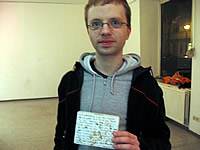 Also
there was Magnus Schaefer. Magnus writes for Vital
Weekly, "an e-mail magazine, which appears 48 times a year and has
the latest cd-reviews and news on concerts and festivals". Magnus came
to the finissage to get his copy of the Fifty/Fifty
box [click his picture to enlarge] ... which sort of reminds me that I should
find some time to update the 50/50-pages, and to prepare some more copies
to send out ... (Fifty/Fifty continues to be available, so if you would
like to get one: shout!).
Also
there was Magnus Schaefer. Magnus writes for Vital
Weekly, "an e-mail magazine, which appears 48 times a year and has
the latest cd-reviews and news on concerts and festivals". Magnus came
to the finissage to get his copy of the Fifty/Fifty
box [click his picture to enlarge] ... which sort of reminds me that I should
find some time to update the 50/50-pages, and to prepare some more copies
to send out ... (Fifty/Fifty continues to be available, so if you would
like to get one: shout!).
Magnus reviewed our parisian
trio in La Miroiterie, with Philippe Simon, and the Fifty/Fifty, in
issue 566 of Vital Weekly, ( ** ) but as you may understand,
just writing a review will not get you a complete Fifty/Fifty ... So this
was the deal: we would give Magnus a box and a cassette, and he
himself would buy the dictaphone to play the tape on, and complete
the object; in return Magnus made and send us a
fifty minutes field recording / reportage about his acquisition of the
dictaphone ... ( *** )
Here's what Magnus writes about it himself, in an email dated april 25th, 2007 ... Much looking forward to actually listening to his recording ....
"ich habe jetzt ein dictaphon zu dem fifty/fifty-tape gekauft, auf dem flohmarkt am mauerpark, 3 euro. ein sehr schoener kauf, insofern es funktioniert, allerdings nicht reibungslos. manchmal kann man kassetten damit abspielen, manchmal nicht. also so individuell, wie ein guter flohmarktkauf sein sollte. das dictaphon ist etwa doppelt so gross wie ein normales, also zu gross fuer die box. es benoetigt vier batterien und wird dadurch ziemlich schwer. das eingebaute mikrophon scheint zu funktionieren, aber der 'record'-knopf nicht.. das schoenste an dem geraet ist wohl, dass es manchmal ein lautes brummen erzeugt (ohne dass eine kassette eingelegt ist), dessen frequenz und intensitaet sich mit dem lautstaerkeregler veraendern laesst. und euer konzert klingt auf tape und mit einem walkman gehoert tatsaechlich viel besser als digital. die aufnahmen selbst habe ich mit meinem geliebten "standard radio company"-kassettenrekorder gemacht. ca. 25 - 30 jahre alt, sehr gross, sehr schwer, etwas kaputt. das (zugehoerige) mikrophon hing aus meiner tasche heraus. die ersten zehn minuten dokumentieren meinen gescheiterten versuch, auf einem flohmarkt in der schlesischen strasse, ecke cuvrystrasse einen walkman zu kaufen. der versuch scheiterte, weil es den flohmarkt nicht mehr gibt. jedenfalls hoert man mich auf meinem fahrrad durch kreuzberg fahren. goerlitzer park und wrangelkiez. der rest der aufnahmen ist dann einen tag spaeter entstanden, ein teil meiner u-bahnfahrt nach prenzlauer berg. der weg fussweg zum mauerpark. flohmarkt. am interessantesten sind wohl die vielen unterschiedlichen sprachen, die es zu hoeren gibt. und insgesamt kommt es dem, was du, harold, ueber die aesthetik von field recordings schreibst, schon sehr nahe."
[ acoustic flux ] [ sonanismo ] [ bergsonian flux ] [ fifty2 ] [ magnetic {eye} ]
And then there was Gunter Krüger.
I was very happy to meet Gunter...
In the year 2000 he picked up the debris of magnetic tapes that he came
across in the city of Jerusalem, during his stay at the Bezalel Academy
of Fine Art there. Between march 01st and june 20th, he collected both cast
away audio- and videotapes in the streets of Jerusalem. These found
tapes in an intricate manner became - to a large extend - subject, content
and script for his video-film entitled Magnetic {eye} - Jerusalem
(2002).
And even though you will be able to see and hear what was on the tapes
that Gunter found, you will, however, not encounter a single image
of cassette- or video-tape, twisted, unthreaded, entangled, broken, or otherwise, in Magnetic
{eye} - Jerusalem.
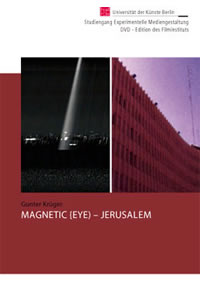 The
film opens with images of a young israeli in a bar, or club, with loud
music playing. He is asked: "Tell me, where can you go in Jerusalem,
on a friday evening?" The young man starts summing up some clubs
and places, but then adds that, "really, there is nothing going on in
Jerusalem."
The
film opens with images of a young israeli in a bar, or club, with loud
music playing. He is asked: "Tell me, where can you go in Jerusalem,
on a friday evening?" The young man starts summing up some clubs
and places, but then adds that, "really, there is nothing going on in
Jerusalem."
It is a curious start.
Is there nothing going on in Jerusalem?
In what follows the maker, in 33 short scenes, takes us to 31 different
places in Jerusalem. Each of the scenes starts with a black screen. Then
the name of a place is indicated: Henriette Szold Street; and a
date: 15-06-2000. In the beginning of the film, for the first four
scenes, the date is preceded by the indication 'videotape', or 'audiotape':
this does suggest that what we (are about to hear) and/or see, is material
recovered from magnetic tape found at the indicated spot on the indicated
day; this then fades into a short film sequence shot at that same spot.
And nothing much happens. Birds are singing. A flag is waving. We hear the
distant sound of traffic, voices ... The first few chapters are like moving
postcards (videa's) from a deserted suburbia.
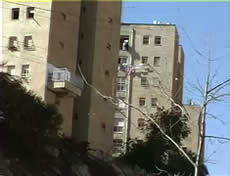 |
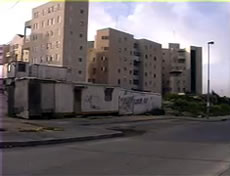 |
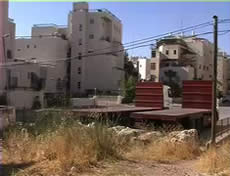 |
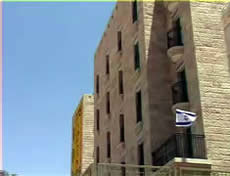 |
As of the fifth spot (Efratah Street) the indication 'videotape'
or 'audiotape' is no longer given. Maybe we are supposed to now have understood
the idea, and as of now it should be clear what is the found
material that triggered the scene?
We first become aware that there must be more to this city than the detached
suburban emptiness that we witness, when we come to a place called Hussein
Palace, 20.06.2000. We hear somewhat meditative sounding instrumental
music, with an 'eastern air', using acoustic and electronic instruments.
One of course suspects these sounds to be part of an audiotape found near
there, but the chapter then surprisingly continues with shaky and coarse-grained
black and white film footage of what looks like ruins on a hill top. That
must be Hussein Palace ... But was this footage found
there? Or is it a filmed sequence only made to look as if 'old and found'?
Or maybe it was found elsewhere? Then color comes back in, and on the same
spot a man is being interviewed, who explains that we are at the site of
king Hussein's summer palace, the construction of which came to a grinding
halt with the six day war of 1967.
Then there is other 'old and found looking' footage, and the chapter ends
with some questions to a girl (maybe the man's daughter?). "Do you know
what the name of this hill is?" she is asked. The girl hesitates, then
says that she forgot ... We vaguely hear the sound of sirens, and then the
music starts again.
For me this was a key moment: there are no answers ...
No answer as to what it is that is being celebrated or commemorated in Gershon
Agron Street, and on Za'Hal Square where people are standing
still, motionless, while sirens are wailing. And no answers to what is happening
there in Jaffa Street, where the police closes off the road, while an officer
carefully approaches what must be 'a suspicious parcel' left behind at a
bus stop. And no answers even when, for (for the viewer) unclear reasons
Gunter is being identity checked at King George V by some ferocious
looking police men, who ask him: "How long are you here?" ... "And
will you come back?" ... There are no answers ...
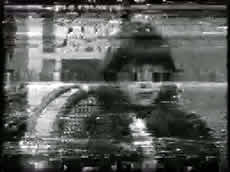 |
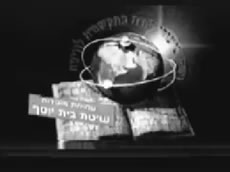 |
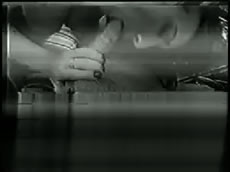 |
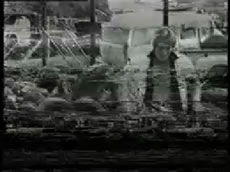 |
The subsequent absurdity of the three Ibn Shaprut sequences in the second part of the film, instructions on how to set a great cup of turkish Aladin coffee, breaks a lot of the tension built up in the detached, almost abstract, city places sequences, but in doing so they also add to 'the mystery'. Why this sketch? How is it related to the 'Creative Labs' intro, that does look like it came from a found video? The 'sketch' cannot be from a found tape, or can it? And the guy making the coffee, is that Gunter? How is this room, this 'inside' related to the outside 'found footage' spots? Can this be the room or apartment where the author was living during his stay in Jerusalem? Is that why Ibn Shaprut on the DVD's cover does not figure in the list of finding places? Is it a joke?
Magnetic {eye} - Jerusalem traces an idiosyncratic and erratic path through the city, high lighting a spot for no other reason than that (pieces of) magnetic tape were found lying there. It is a random walk with many surprises, and many interesting and sometimes funny encounters between found audio / video and the spots where they were found. (One of my favorites: that at Agripas Street.)
From a technical point of view, Gunter's project also seems to once more illustrate how much more difficult it is to 'restore' found video tape ( **** ) than it is to 'restore' audio tape. Much of the found video footage appears to be nearly impossible to 'track', and its playing back gives rise to not much more than what one might call a 'glitch clip'. Some of these are great, though ... (let me again mention a favorite: Shivtei Yisra'el Street).
I'm really pleased having found out about this work, which of course in spirit is very related to the Found Tapes Exhibition. It also makes me the more curious to see that other early 'found tapes' film that I know about, Lost Sound, by John Smith and Graeme Miller ... to enjoy, and compare ...
[ Unlike 'Lost Sound', you can watch Magnetic {eye}-Jerusalem online, in Quicktime format. And when you like it, of course you support the artist by ordering and buying, for only 15 euros, a copy of the DVD, that comes with many extras: a whole series of additional found audio tracks, a view according to finding place, and a whole series of 'chapters' corresponding to finds and finding spots, that did not make it to the final cut ... ]
notes __ ::
(*) This is the spanish text: "Entre los distintos
niveles interpretativos desde los cuales puede analizarse esta pieza, es
posible encontrar en ella una lectura crítica, o al menos irónica,
respecto a ciertas asunciones típicas de los ámbitos creativos
normalmente denominados como “arte digital”, “arte electrónico”
o “media art” (ámbitos dentro de los cuales Sonanismo
puede incardinarse fácilmente). Más allá de que el
propio tema de la masturbación pudiera entenderse como una posible
apelación al notable talante endogámico que caracteriza la
difusión de las mencionadas prácticas artísticas (ya
que la mayor parte de los asistentes a los festivales y muestras consagrados
a estas actividades suelen ser personas dedicadas más o menos directamente
a esas mismas actividades, produciéndose una curiosa identificación
entre productores y receptores), la pieza también intenta plantear
una reflexión acerca del concepto de interactividad, omnipresente
en los citados ámbitos estéticos."[
^ ]
(**) "{HARS/SIMON/VAN ALEBEEK - __Trio (3"
CD-R by Postcard from Paris)} This is a total lo-fi affair, a 16-minute
buzz of frenetic violin playing, found voice sounds, crude tape manipulations
and bizarre rumblings. And, yes, it's great. Sure, the energy this must
have had live is not captured, since the sound quality is pretty mediocre.
However, this intensifies the lo-fi-character of the music even more and
thus, rather than being a poor reproduction, it adds up to the existing.
Right from the start they go at full volume, with snippets and washes of
sound swirling in and out of the mix - or maybe rather mud. Schellinx's
and van Alebeek's approach to working with tapes is not so much about radical
abstraction, as for example Howard Stelzer's, but they are rather using
their Dictaphones as playback devices with possibilities for spontaneously
manipulating the sound, while the focus is on exploiting the inherent technical
limitations to transform and obscure whatever sound finds is way on the
tapes. So, as said, in combination with Simon's straightforward violin-scraping
and blurred even further by the recording quality, this makes up for a great
piece of lo-fi drone noise.
{HARS/VAN ALEBEEK - Fifty/Fifty (Tape and Walkman by Fifty/Fifty)}
Both Schellinx and van Alebeek turned fifty last December, and on this occasion
they played a short concert together, which is now released on tape, in,
of course, an edition of fifty. Music-wise this goes in the same direction
as the trio recording reviewed above. Voices, singing and talking, found
and plundered, play an even greater role, mixed with field recordings, rudimentary
electronic noises and snippets of popular music (which I, as usual, cannot
identify, although they sound so very familiar) and again obscured and melted
together by the overall lo-fi sound. It's nice, albeit without Simon's violin
it somehow lacks the upfront energy that was so fascinating about the recording
reviewed above. However, this release is not only a tape, but each of the
tapes comes with a functioning walkman cassette player (either found or
bought second hand at garage sales, flea markets, thrift stores, etc.),
and everything is packed in nice, individually decorated boxes. As a concept
this is really great. It pushes the lo-fi aspect of the whole affair to
the limit, with the inbuilt speakers of the walkmans transforming the sounds
even further (at least that's how I imagine it, I only got a CD-R and played
it back over the inbuilt speakers of my notebook) and combining it with
the poetics of cheap disposable electronics and thrift store finds. (MSS)"
[ ^ ]
(***) As we do not want to be accused of any form
of favoritism, please note that we will gladly extend this offer
to any other reviewer willing and able to publicly let his or her light shine
on the Fifty/Fifty release. Please contact us by using
the mail me link in the upper left part of this page. [
^ ]
(****) Early on, when I began picking up cassette tape, I also collected the
pieces of discarded VHS and other video tapes that I found lying around; but I gave that up when I
found out how difficult and time consuming it was to wind video tape back into a video-cassette and
have it play back without messing up over and over again ... I tried once or twice, but
then decided to stick to audio. [
^ ]